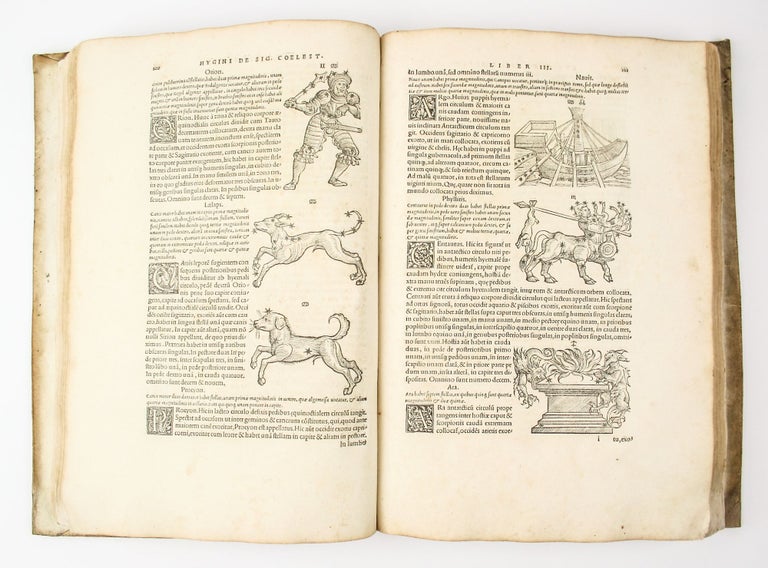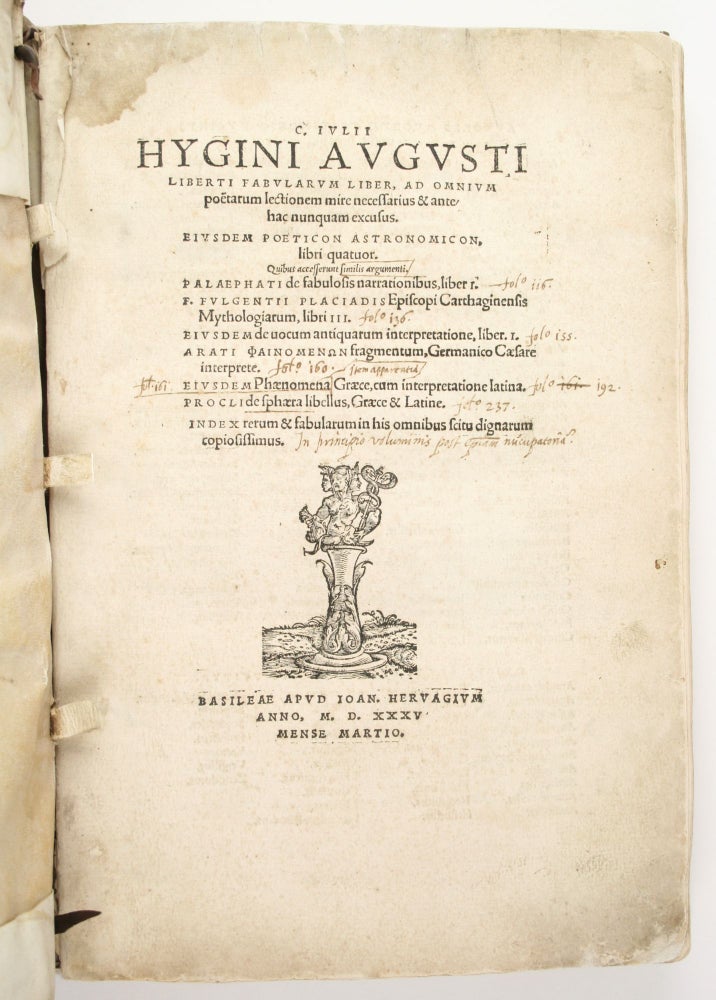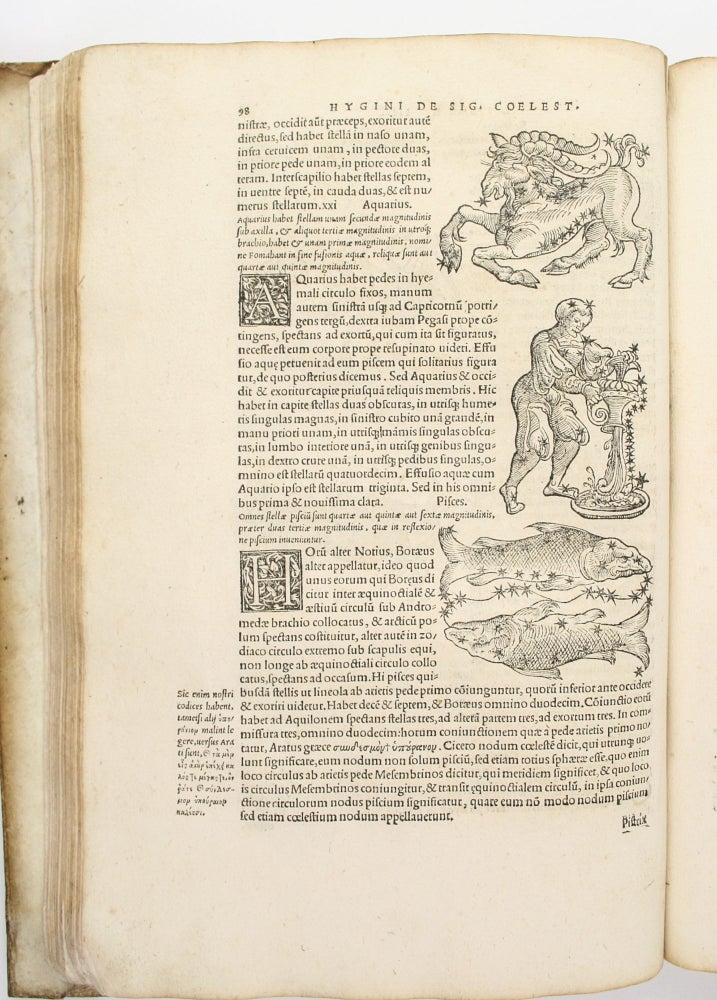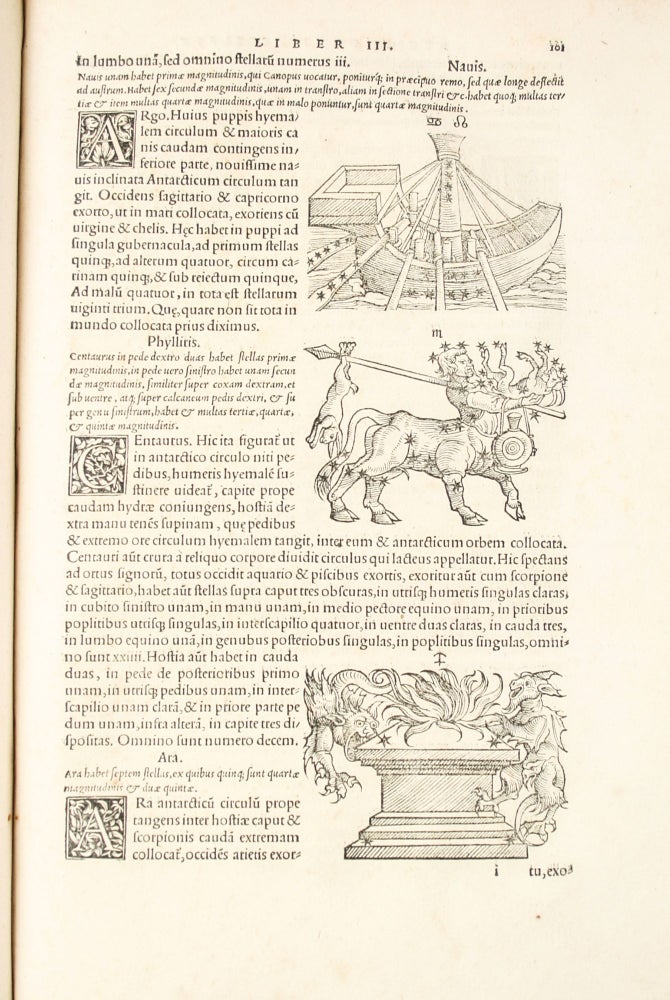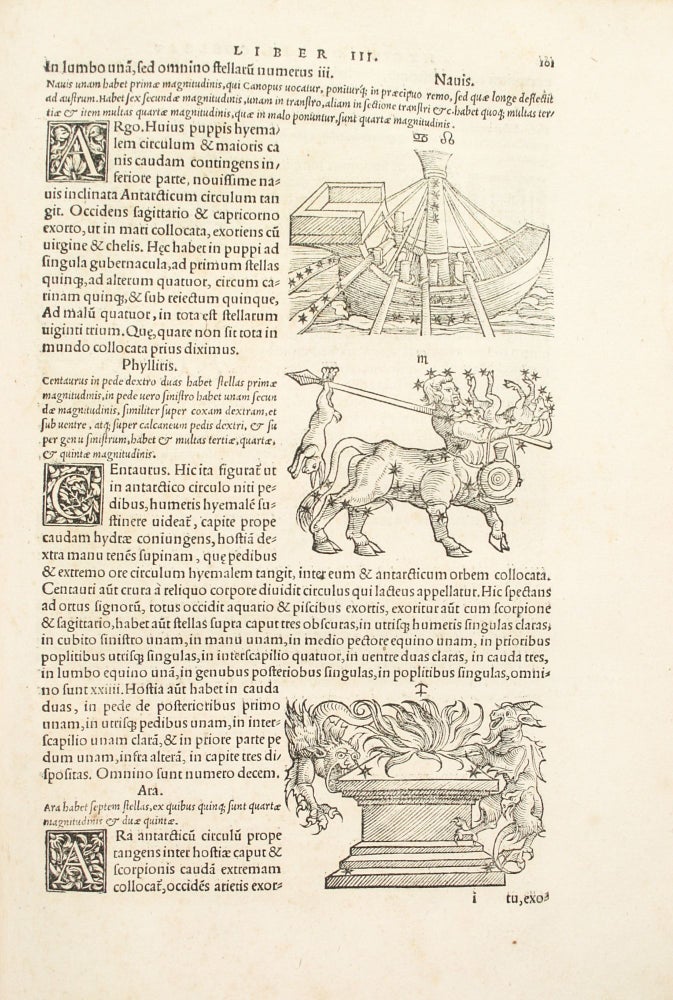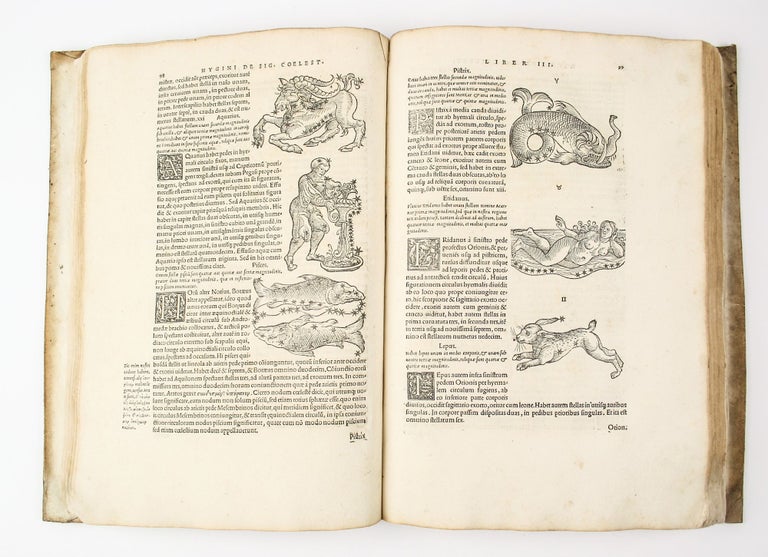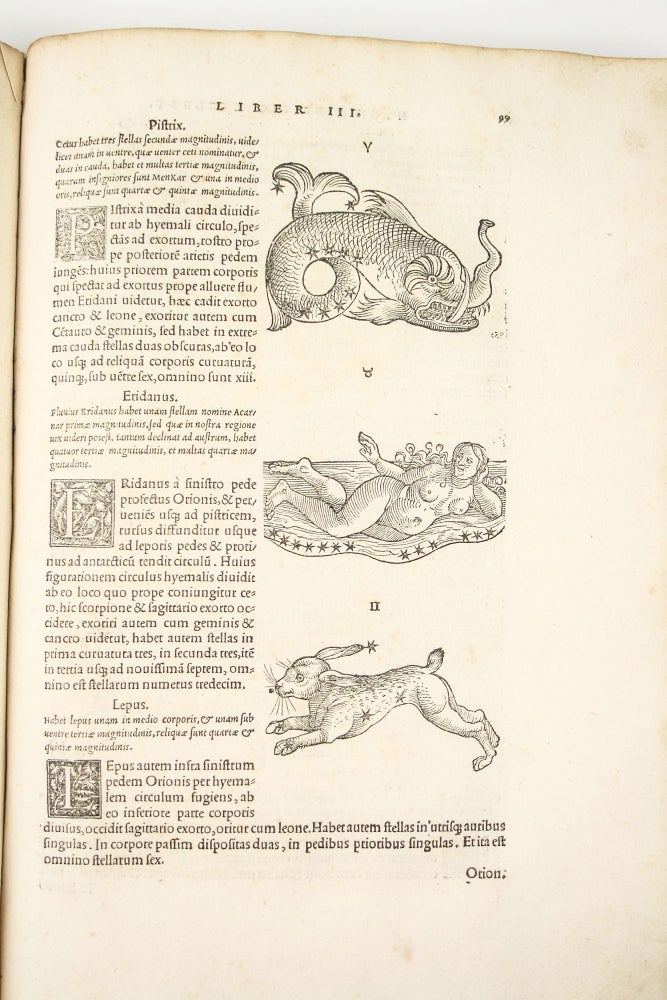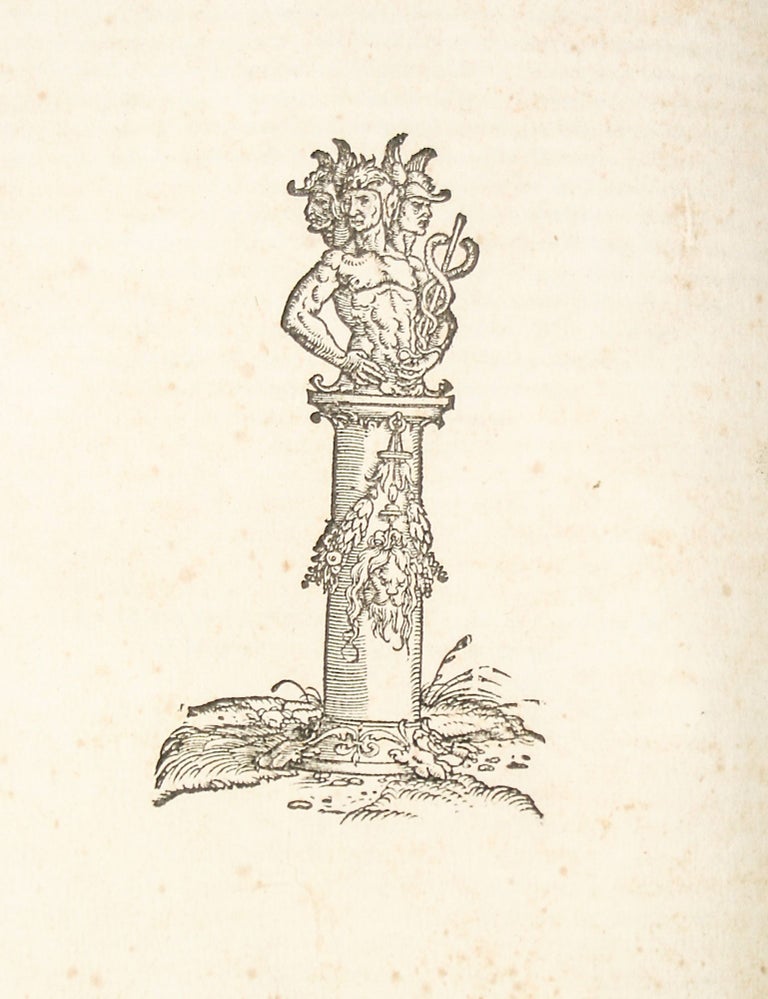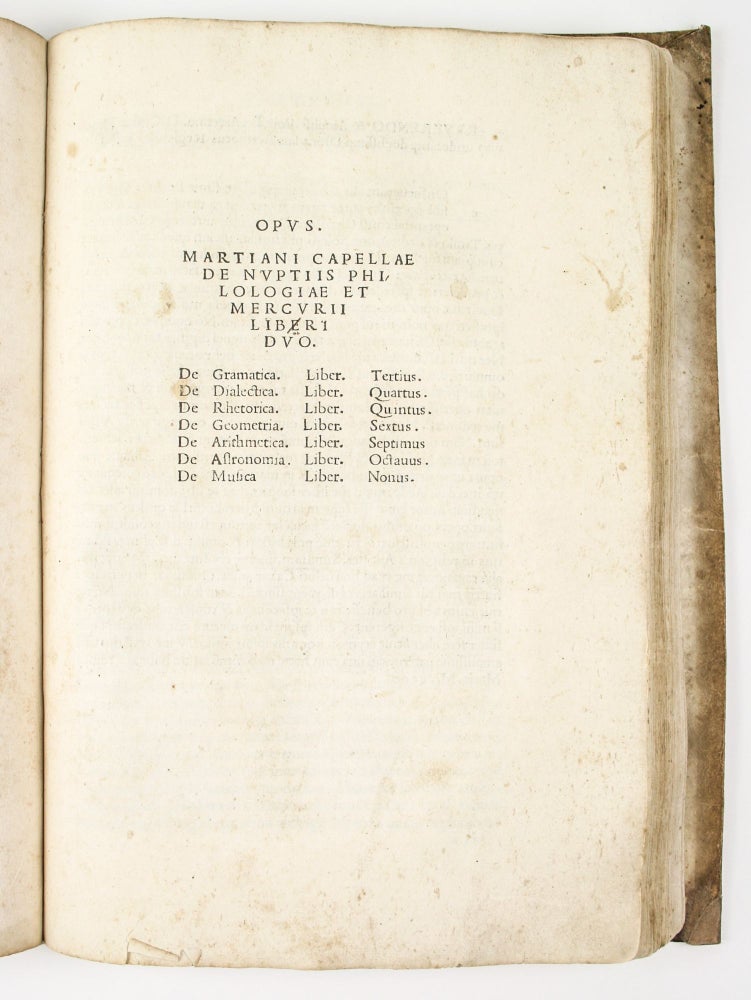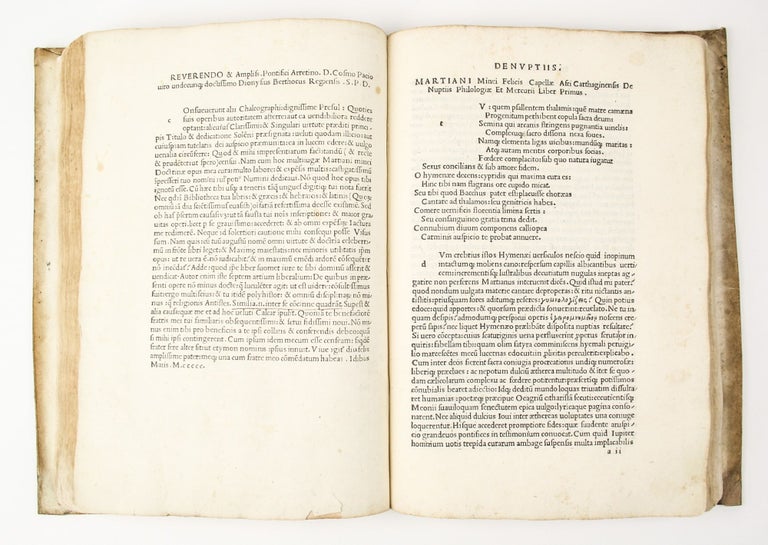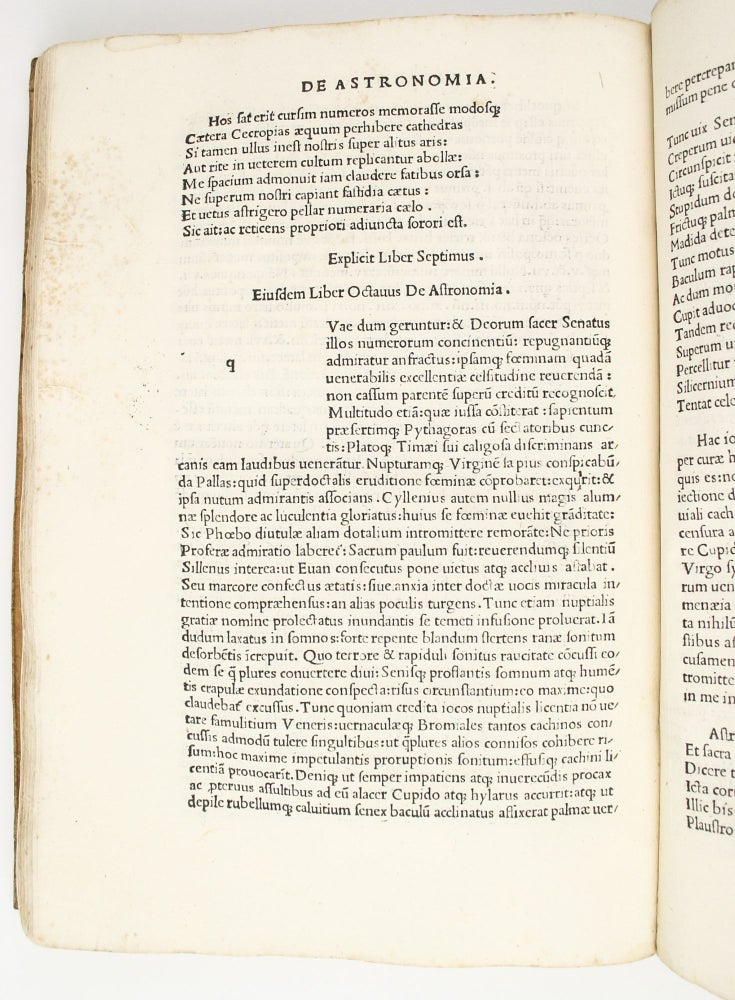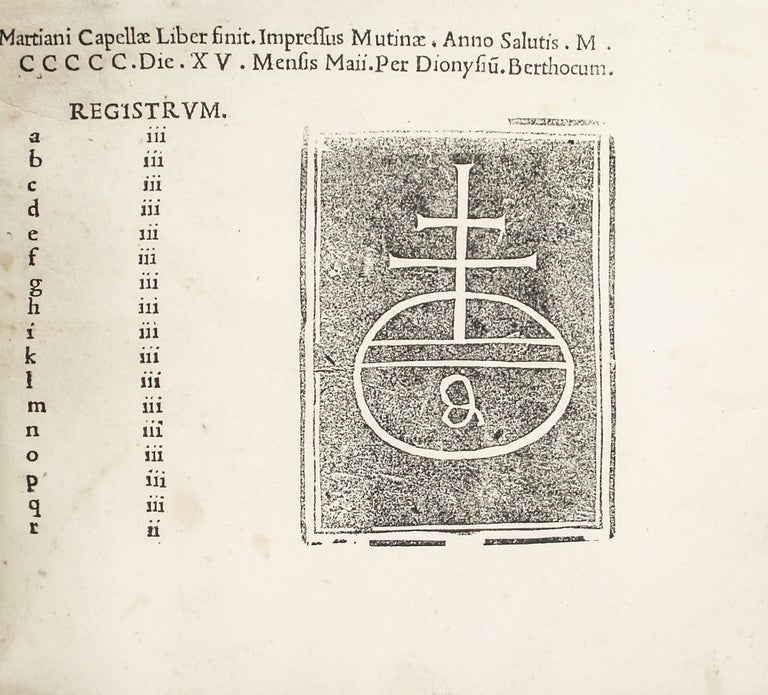Opus Martiani. Capellae de Nuptiis Philologiae & Mercurii libri duo. De Grammatica. Liber. Tertius. De Dialectica. Liber. Quartus. De Rhetorica. Liber. Quintus. De Geometria. Liber. Sextus. De Arithmetica. Liber. Septimus. De Astronomia. Liber. Octavus. De Musica. Liber. Nonus.
Modena: Dionysius Bertochus, 15 May, 1500.
Price: $28,000.00
Folio: 30.5 x 20.5 cm. I. 100 leaves. a-q6, r4; II. alpha-gamma6, b-d6, e8, f-i6, l4, m-p6, q4, r-x6
SECOND EDITION (1st 1499) of the Capella, FIRST HERWAGEN EDITION of the Hyginus.
Bound in 16th c. limp vellum. Fine, broad-margined copies on thick paper with just some occasional light soiling and a few instances of foxing in the Hyginus and a dampstain to the upper, inner corner of opening leaves.
Bound with:
Hyginus, C. Julius (1st century A.D.); Aratus, of Soli. (c. 315-c. 245 B.C.); Proclus Diadochus (ca. 410-484)
Fabularum Liber, Ad Omnium Poetarum Lectionem Mire necessarius, & nunc denuo excusus: Eiusdem Poeticon Astronomicon Libri quatuor. Quibus accesserunt similis argumenti, Palaephati de fabulosis narrationibus, Liber I. F. Fulgentii Placiadis episcopi Carthaginensis Mythologiarum Libri III. Eiusdem de vocum antiquarum interpretatione, Liber I. Phurnuti De natura deorum, sive poeticarum fabularum allegorijs, speculatio. Albrici philosophi de Deorum imaginibs Liber. Arati Phainomenon fragmentum, Germanico Caesare interprete. Eiusdem Phaenomena Graece, cum interpretatione Latina. Procli de sphaera libellus, Graece & Latine. Index rerum & fabularum in his omnibus scitu dignarum copiosissimus.
Basel: Per Ioannem Heruagium, 1535
Two fine early astronomical works bound together. The Capella, printed at Modena, is the second of only two editions printed in the 15th c. The Herwagen edition of Hyginus features a new series of woodcuts of the constellations, and includes the Greek texts of Aratus and Proclus.
I. Capella and Heliocentric Orbits:
Although it is an ancient text, Capella's work has a notable place in the history of early modern astronomy. Copernicus praised Capella's model of the solar system, which included heliocentric elements. Although Earth was still at the center in Capella's system, Mercury and Venus circled the Sun. According to Capella, Mercury and Venus rotate around the sun, because these planets diverge no farther than from the sun than is permitted by the curvature of their revolutions. Copernicus argues that Capella’s approach to the so-called lower planets should be applied to all the planets, so, since the sun remains stationary, whatever appears as motion of the sun is really due rather to the motion of the earth. Copernicus wrote:
'I judge that what Martianus Capella and some other Latins took to be the case is by no means to be despised. For they hold that Mercury and Venus do not have any further elongation than the sun than the convexity of their orbital circles; for they do not make a circle around the earth as do others, but have perigree and apogee interchangeable [in the sphere of the fixed stars]… Thus the orbital circle of Mercury will be enclose within the orbital circle of Venus –which would have to be more than twice as large- and will find adequate room for itself within that amplitude.'(De Revolutionibus)
“One cannot read Martianus’s book cursorily —one must tackle it— and the reader is immediately at a loss to explain how a book so dull and difficult could have been one of the most popular books of Western Europe for nearly a thousand years. We moderns may be repelled by the style and content of the De nuptiis, but vernacular readers and medieval students seeking an introduction to the learned arts and finding in Martianus’s work a fairly compact treatise dressed in fantasy and allegory were both charmed and edified by it…
“The De nuptiis, according H.O. Taylor, was ‘perhaps the most widely used schoolbook of the Middle Ages.’ It would be hard to name a more popular textbook for Latin readers of later ages. It had to withstand keen competition from Boethius, Cassiodorus, and Isidore of Seville, but it had the salient advantage of offering a well-proportioned and comprehensive treatment of all the liberal arts in the compass of one comfortable-sized book. The De nuptiis was the foundation of the medieval trivium and quadrivium. Since it recapitulated the fundamentals of the Roman academic curriculum and transmitted them to later generations of students, the book must be regarded as the key work in the history of education, rhetoric, and science during this period…
“It is not surprising that Book VIII of the De nuptiis has been of great interest to historians of science. Their interest has been stimulated by Copernicus, who singles out Martianus to bestow lavish praise upon him for propounding a theory of heliocentric orbits for Venus and Mercury.” (Capella and the Seven Liberal Arts by William Harris Stahl, Richard, and Evan Laurie Burge)
The Printer: “An edition of the poems of Tibaldeo dated May 13, 1499 (Hain-Reichling 15452), and the Crastonus of October 20, 1499, and the Capella of May 15, 1500, are all that can be assigned with certainty at Modena to Dionysius Bertochus (from Reggio Emelia), who worked at Reggio in 1496 and 1497 and had returned thither by July, 1501.”(BMC VII, 1067)
II. Hyginus, Proclus, Aratus, et alii.
The Hyginus of 1535, printed at Basel by Herwagen, is particularly notable for the inclusion of a set of forty-eight fine woodcuts of astronomical figures, newly cut for this edition. The volume includes not only Hyginus' "Poeticon Astronomicon" and his "Fabularum Liber" but also other early astronomical texts. These include Aratus' "Phaenomena", Proclus' "Sphaera" (both of which are printed in the original Greek and are accompanied by Latin translations), and more obscure texts: "De fabulosis narrationibus" by Palaephatus; "Mythologiae" and "De vocum antiquarum interpretatione" by Fulgentius; Phurnutus' "De natura deorum speculatio"; and Albricus' (13th c.) "De Deorum imaginibus Liber".
1. "Under the name of Hyginus two school treatises on mythology are extant: (1) "Fabularum Liber", some 300 mythological legends and celestial genealogies, valuable for the use made by the author of the works of Greek tragedians now lost; (2) "De Astronomia", usually called "Poetica Astronomica", containing an elementary treatise on astronomy and the myths connected with the stars, chiefly based on the work of Eratosthenes. Both are ‘abridgments and both are by the same hand; but the style and Latinity and the elementary mistakes (especially in the rendering of the Greek originals) are held to prove that they cannot have been the work of so distinguished a scholar as C. Julius Hyginus. It is suggested that these treatises are an abridgment (made in the latter half of the 2nd century) of the "Genealogiae" of Hyginus by an unknown grammarian, who added a complete treatise on mythology." (EB)
2. Aratus’ “Phaenomena”:
Born in the city of Soli in Cilicia, Aratus studied under the Stoic philosopher Zeno, through whose influence Aratus entered the court of Antigonus II of Macedonia. It was at Antigonus’ request that Aratus composed his long astronomical poem, the “Phaenomena”. The poem, Aratus’ only extant work, is valuable for preserving what is considered to be the first star catalogue, that of Eudoxus of Cnidus (368 B.C.). After the famous prelude, Aratus describes the northern and southern constellations and the circle of the celestial sphere. Next, he deals with the calendar and the hours of the rising and setting stars. Then follows a discussion of the days of the lunar month, followed by the seasons, and then the Metonic cycle. The second part deals with meteorology -an integral part of the main text, even though ancient commentators give it a separate title. After a transition, Aratus deals with the signs derived from the observation of the sun, stars, and other celestial phenomena. He ends with a description of the signs that depend on terrestrial phenomena. Individual stars are differentiated by their brilliance. Aratus’ work was enormously popular, inspiring a whole sub-genre of translations and imitations, the three most important of which are included in this volume. By firmly establishing the figures associated with the constellations, the work had an important influence on sixteenth and seventeenth-century celestial cartographers, such as Johann Bayer.
3. Proclus’ “Sphaera”:
This work, transmitted under the name of Proclus, is considered to be largely the work of the stoic philosopher Geminus of Rhodes (fl. ca. 10 A.D.), a student or later follower of Posidonius.
Drawing on the work of earlier astronomers such as Hipparchus, the “Sphaera” begins with an explanation of the astrological aspects of astronomical signs and their influence on human affairs. Next come chapters on the constellations, the circles of the celestial sphere, and a discussion of the variations of the length of day and night at different latitudes. Chapter 7 -based largely on Hipparchus and his commentary on Aratus- deals with the rising of the zodiacal signs and the length of the lunar month, with explanations of the phases of the moon, lunar eclipses, and the general motion of the planets. This is followed by discussions of the rising and setting of the fixed stars, the zones of the terrestrial globe, and the principles upon which “parapegmata” (astronomical calendars containing weather prognostications that contain the rising and setting of certain stars and constellations) are based. There is also a chapter dealing with the deals with the “exeligmus”, or shortest period containing a whole number of synodic months, of anomalistic months, and of days, also treated in the Almagest (IV, 2).
In addition to the Greek text, this edition also includes the Latin translation by the English humanist scholar Thomas Linacre. Linacre traveled to Italy in 1487 to study with the Greek scholar Demetrius Chalcondyles and the Italian humanist Angelo Poliziano. From 1497 to 1499 Linacre assisted Aldus in printing the “editio princeps” of the Greek text of Aristotle. His work on the Aldine Aristotle and his translation of the “Sphaera” are the most important contributions to the revival of Greek learning by an Englishman in the fifteenth-century.
I. Goff C-118; Hain 4371*; Klebs 668.2; Smith (Rara Arithmetica) p. 67; Pell 3225; IGI 2427; Pr 7215; BMC VII 1068 (IB 31860). II. Wellcome I, 3377; Zinner 1592


